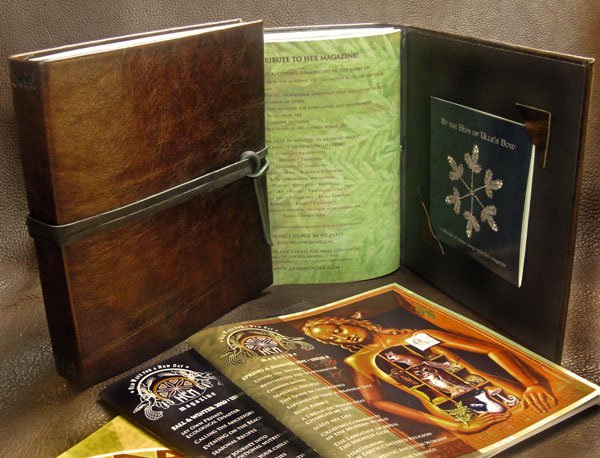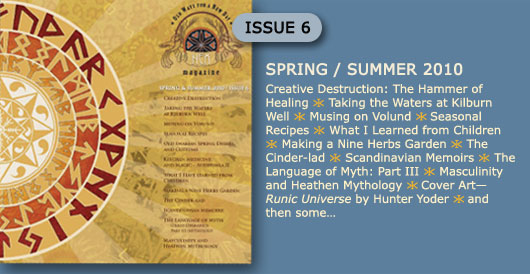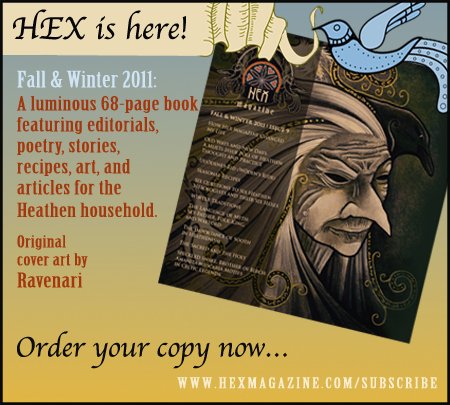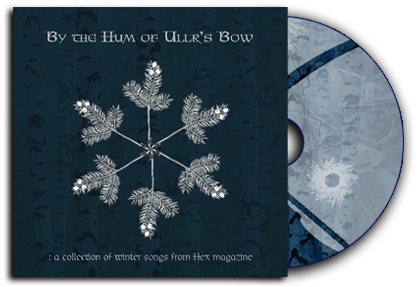Hex Issue 9 Autumn/Winter 2011 is Here!
Support Hex! We are a community-supported not-for-profit publication. You can support us by heading to http://hexmagazine.com/subscribe/ and ordering magazines, CDs, and prints, and by spreading the word to all like-minded folk!
* * * * * *
~ Call for Submissions ~
Hex Magazine is always seeking fresh contributions! We’re keen both to nurture new talent and to honor established thinkers! Join us: Submissions for Issue 11 (Autumn 2012) due Spring Equinox 2012.
Submission guidelines are available at http://hexmagazine.com/submit/guidelines/
And don’t forget: the much anticipated Hex Folk Market (www.hexfolkmarket.com) is here! Join our online market community in celebration of folk ways and sustainable living. Browse through our selection of international merchants or set up your own shop for free!
* * * * * *

Kitchen Medicine and Magic: Lacto-fermented Cucumbers
As Harvest month moves into Shedding month, cooler early morning temperatures reveal that Nerthus is shedding her summer coat. As Sunna rises though, so does the thermometer! Here in eastern Georgia we’ve experienced daily 90 Fahrenheit plus temperatures since spring, so at this point fall can’t get here soon enough!
The garden is also shedding, as summer crops show signs of decline from heat and insects. Despite such stressors my best producer this year has been the package of pickling cucumber seeds I planted near the compost pile. Within about 9 weeks we started eating the 3 to 4 inch long fruits and have been eating fresh cucumbers daily all summer. We’ve also managed to fill a couple of dozen jars with yummy dill pickle relish, along with my grandmother’s pickle, the bread-n-butter pickle. Most recently I’ve begun to make probiotic-rich lacto-fermented pickles which do not utilize vinegar, and they are so easy to make and so tasty that they are rapidly becoming a favorite!
Cool as a Cucumber
The phrase cool as a cucumber (which dates from c.1732) embodies ancient folk knowledge confirmed by science in 1970: on a warm day the inside of a field cucumber is 20 degrees cooler than the surrounding air temperature.
Cucumbers (Cucumis sativus) come from the large cucubitaceae family which consists of about 960 species that range across all the temperate regions of the world. Other species in the cucumber family include yellow summer squash, zucchini, pumpkins, winter squashes like acorn and Hubbard’s, as well as water-melons and cantaloupes. Most are annual but some are perennial, like chayote squash.
Records from the Anglo-Saxon Lacnunga Manuscript (c. 9-11th century) and the Old English Bald’s Leechbook (c. 9th century) both contain remedies that utilize cucumbers in healing formulas – both internally and externally.
The cucumber comes in a variety of sizes and colors and originated in the Middle East. They were known in Egypt at least 3000 years ago. Eventually they made their way to Greece and Rome and began to spread across Europe . The Roman Emperor Tiberius (42 BCE-37 CE) was known to enjoy cucumbers both summer and winter.
“Indeed, he [Tiberius] was never without it; for he had raised beds made in frames upon wheels, by means of which the cucumbers were moved and exposed to the full heat of the sun; while, in winter, they were withdrawn, and placed under the protection of frames glazed with mirrorstone.” – Pliny the Elder
Columbus brought cucumbers to the New World, and the Jamestown colonists had them in their gardens by 1609. Contemporary Heathens can everywhere can enjoy cucumbers in one form or another, and no smorgasbord is complete without them.
Currently cucumbers are the fourth most widely cultivated vegetable in the world. There are hundreds of cultivars but those most often found in the grocery store are either the slicing type or the pickling type. Cucumbers pack many health benefits in both their flesh and their seeds. They contain phytonutrients with antioxidant, anti-inflammatory, and anti-cancer benefits. They also a good source of Vitamin C and A, potassium, folate, magnesium, manganese, and silica, as well as dietary fiber. Unfortunately many cucumbers available today have been coated with wax and in my opinion should be peeled before use. Buying organic cucumbers and/or from farmers’ markets is a simple way around this (and other) problems, of course.
Lacto-fermented Cucumbers
Whey has been traditionally used to preserve many foods: vegetables, fruit, dairy, meat, even fish. Lacto-fermented vegetables are a common preserved food made with whey – cabbage, carrots, beets, radishes, and more…including cucumbers! I obtain my whey by straining plain yogurt: the whey drips out and I save all of it (this, incidentally, also turns the yoghurt into delicious cream cheese). Some of the whey goes into the cucumbers and the rest is used for pre-soaking grains (described in the Feast of Bread 2011 Hex Newsletter), and beans, which should make another great article.
Lacto-fermented Cucumbers from Nourishing Traditions by Sally Fallon
4-5 pickling cucumbers or 15-20 gherkins
1 tablespoon mustard seeds
2 tablespoons fresh dill, snipped (I use 1 tablespoon of dill seeds)
1 tablespoon sea salt
4 tablespoons whey (if not available, use an additional 1 tablespoon salt)
1 cup plus of filtered water
Wash cucumbers well, cut off blossom ends and cut into 1/4 in slices. Place in a quart-sized wide mouth jar; I use an old pickle jar.
Combine remaining ingredients and pour over cucumbers, adding more water if necessary to cover the cucumbers. The top of the liquid should be at least 1 inch below the top of the jar.
Cover tightly and keep and keep at room temperature for about 2 to 3 days before transferring to refrigerator. Enjoy a few everyday!
September Monthly Highlights:
1 – First Labor Day in USA celebrated in 1894
1-10 – Mercury brightest star in morning, look in east/north east sky
4 – Moon in first quarter 1:39pm EDT
5 – Labor Day Celebrated, USA
6 – Pilgrims sailed for America 1620
8 – First public school opened in America 1621
9 – Herman of Cherusci’s Day
9 – The term United States becomes official 1776
11 – Grandparents Day
11 – World Trade Centers Twin Towers and the Pentagon are attacked 2001
12 – Full Harvest moon 5:27 am EDT
14 – Moon begins decreasing time to plant below ground crops
17 – US Constitution adopted 1787
20 – Moon in last quarter 9:39 am EDT
21 – Russia explodes first atomic bomb 1949
21 – Mabon
23 – Autumn Equinox 5:04 am EDT
23 – Some Heathens celebrate Winter Finding now, while others celebrate on the next full moon after Equinox which is on October 11
23 – Southern Hemisphere, Spring Equinox, Ostara
27 – New moon 7:09 am EDT
29 – Moon begins increasing time to plant above ground crops
29 – Michaelmas – UK
Hail Day!
~ Teresa L. Hedgewife
* * * * * *
Leather Bound Limited Edition of Issues #5–8 + CD!

An edition of 13, and signed by the artisan (Jason Hovatter) and editors of Hex. One copy is very, very special (see photograph below).
Each copy is $100 + shipping, except the special edition which is $150 + shipping. If you want to order send me an email: arrowyn@hexmagazine.com. It’s first come…first serve!
Note: Issue #5 is sold out – this is a small reprint run.
All proceeds go to Hex Press to support its continued effort to provide folks with an excellent volunteer-based, community-supported, not-for-profit publication.

* * * * * *
Feeling Hexy?
Hex is putting out an initial call for Heathen Erotica.
For a side project, not a regular issue.
It will be published when we get enough material.
Accepting submissions for stories, poetry, art, photography, recipes, whatever.
You can submit under your own name or a nom de plume.
The usual high standards of quality apply! IE: if it’s smut, it better be really good smut!
Send submissions to submissions@hexmagazine.com
* * * * * *

•Berkano•
Old English Rune Poem
Beorc (Birch) is lacking fruit; it bears even so
sprouts without seed; its boughs beautiful,
high on top, fairly decorated;
grown with leaves, close to the sky
Old Icelandic Rune Poem
Bjarkan (Birch) is a leaf covered limb
and a slender tree
and a spritely wood
Old Norwegian Rune Poem
Bjarkan (Birch) is leaf-greenest of limbs;
Loki bore treachery’s fortune
~ Rune poem translations by Sweyn Plowright, http://www.mackaos.com.au/Rune-Net/Primer/
Here in Portland we’re seeing the culmination of summer and the threads of harvest time drawing together. Although I don’t live a rural life, I’ve been doing a bit of preserving and pickling, just as folk have done for centuries. It Is a sobering and thought-inducing exercise because it gives the slightest taste of what fertility must have meant to people before freight lines, greenhouses, and refrigerators became common.
A quick glance at the rune poems for Berkano suggests two things. Firstly, that this rune is associated with great life and fertility. Secondly, that this is not the kind of perennial, flourish-then-decay-then-repeat fertility that marks the harvest tide. As an evergreen, there is something both enduring and distant about Berkano’s lush imagery.
The fertility of birch, withdrawn yet rich and eternal. The image of the tree’s branches “close to the sky” conjures an otherworldly atmosphere; yet as a life-filled tree, we cannot help but also visualise its roots digging deeply into the earth. It is a symbol of the whole, each part complimentary to the rest.
So how may we live our lives? One way to is lose ourselves in the worldly. To dissolve ourselves in daily routine, comfortable ruts, enslave ourselves to the familiar. Despite my strong language, I don’t actually think there is anything wrong with such a path (without it nothing would ever get done) so long as it is leavened with moments of perspective…but in modern times it is very easy to become totally devoted to the tyranny of cyclical sleep-walking.
If we are entirely absorbed in the cultivation of fertility (or sometimes, it turns out, a mere semblance of the same) by throwing ourselves into the world( at the expense of questioning and reflecting), then we begin to risk losing our ability to live responsibility.
We become vulnerable to the repetitive messages of powers with ulterior motives; nowhere is this more evident than the fashion in which modern society has handed ecological sustainability over in exchange for the shibboleth of convenience and an illusion of plenty (all while a handful of very rich individuals pocket the profits of this swindle).
If there are ecological and social consequences to being lost-in-the-world of our doings, there are also personal costs. Our deep selves do not run on perfect timetables, nor are they comfortable with being ignored. Part (I emphasise, only part) of the reason why many folk undergo dramatic intensification or change of life path at critical points (e.g. the classic “age 30 transition” is precisely because contemporary society offers a paltry array of opportunities for real reflection and milestone marking.
There is more to life than accrual of wealth – of pursuing thick-laden branches to the exclusion of all else. If we neglect this then we risk burning out, becoming like perennial harvest plants, blooming one minute, barren and cold the next.
Here Berkano points us to the importance of withdrawal, of being “close to the sky.” While total withdrawal from the world would lead to death in short order, Berkano illustrates a third option: to be grounded on earth while simultaneously tuning one’s fertility to the heavens.
It is likely that just about any strategy we use to keep ourselves conscious, present, learning, and questioning will eventually become absorbed into somnolent repetition. So we need to keep swapping things out, connecting with ourselves, periodically giving ourselves space to do nothing and see what emerges in that vacuum of action.
Berkano, in this sense, can be construed as modelling the value of weaving inaction through the fabric of an active life. We are encouraged in modern times to go, and go, and go, and even our pauses for reflection are easily set into neat compartments where they cannot cause too much trouble.
This rune, however, can be the spur for us to embrace the random, the bewildering, to consciously afford ourselves the chance to remember that we are more than units of Brownian motion in a mechanistic universe of the same.
This is an eternal, ongoing tightrope dance: Berkano’s luscious limbs are evergreen because the tree, in this metaphor anyway, never tips over too far toward earth or toward sky. It wants us to resist overbalancing in the name of brute habit.
It might seem like too much effort and trouble to follow the way of the birch. We might think we can take short cuts and ignore the long view, hoping it will go away. Yet even at a planetary level we are seeing the truth of this purportedly cheaper option: ecological devastation, economic and social misery. Life becomes cheap when we become unwilling to value it fittingly.
If Berkano, then, is like a way-marker, a thorn in the side of sleep, what might we do with this sudden, troublesome arrival? Like Loki, it may bring uncomfortable change, but bear in mind that even Loki’s greatest mischief, Ragnarok, ultimately turns out for the best.
Daily life conjures the feeling of eternal sameness, but simple common sense exposes this as an illusion, and we are left with the challenge of embracing the delicate tension of the evergreen branch.
It is no easy feat to dismantle, reflect on, and remake one’s life. It is not easy to constantly seek new ways to keep the sting of self-awareness sharp in the rough hide of daily cycles. Let this rune be one dart in the skin of your life and identity’s seeming self-evidence! Berkano invokes in each of us the kind of enduring, this-world-and-the-other-at-once fertility that the silver-barked tree has so majestically mastered.
* * * * * *
By the Hum of Ullr’s Bow: Winter Songs Compilation CD is still available!
Bands on the compilation CD include:
• A Minority of One • Allerseelen • Andrew King • At the Head of the Woods
• Beastianity • Hamramr • Irij • Ironwood • Ruhr Hunter
• Sangre Cavallum • Sieben • Steve von Till
• Svarrogh • Waldteufel • Wardruna
You can read more about the artists here:
http://hexmagazine.com/harvest/winter-songs-cd/
* * * * * *
: Issue Six Almost Gone! :

Issues One, Two, Three, Four, & Five are sold out!
Limited numbers of Hex Issue Six (and also issues Seven, Eight, and Nine of course) remain!
Order at: http://hexmagazine.com/subscribe/
* * * * * *
Until Winternights/Samhain, may you and your household be blessed and kept. Hail!
~ HEX Magazine
* * * * * *
> Please forward to all interested and relevant parties <











Leave a Reply